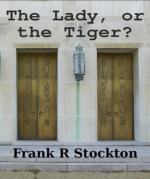
|
| Name: _________________________ | Period: ___________________ |
This test consists of 15 multiple choice questions and 5 short answer questions.
Multiple Choice Questions
1. The king's vast amphitheater is described in Part 2 as "an agent of" what?
(a) "Poetic justice."
(b) "Evolution."
(c) "Change."
(d) "Cruel fate."
2. What word from the narrative means to bring out or to obtain by special means?
(a) Procure.
(b) Endure.
(c) Compose.
(d) Constrain.
3. What theme is introduced in Part 2 of the story?
(a) Revenge.
(b) Family.
(c) Fate.
(d) Romantic love.
4. What pleases the king the most, according to the narrative in the beginning of the story?
(a) "To remind his citizens of his warmth and generosity."
(b) "To uphold justice by the methods delivered him by the great gods."
(c) "To incur upon his community a sense of love, peace, and justice."
(d) "To make the crooked straight and crush down uneven places."
5. How is the arena defined in "The Lady, or the Tiger?"
(a) A staged area for opera performances.
(b) A ring or pit for entertainment or sports.
(c) A platform where dog-races take place.
(d) A forested area set aside for public executions.
6. What does "barbarism" in the narrative most closely reflect?
(a) Masochism.
(b) Passion.
(c) Ambition.
(d) Intelligence.
7. What word from the narrative means certain to happen or a situation that is unavoidable?
(a) Undetermined.
(b) Culpable.
(c) Didier.
(d) Inevitable.
8. When are criminals brought to the king's amphitheater, according to the narrator in Part 2?
(a) "When a subject was accused of a crime that involved murder or theft."
(b) "When a subject was accused of a crime that involved the neighboring kingdoms."
(c) "When a subject was accused of a crime that involved the royal court."
(d) "When a subject was accused of a crime of sufficient importance to interest the king."
9. What does the word "idealism" refer to in the narrative?
(a) The belief in government.
(b) The study of governance.
(c) The belief in God.
(d) The pursuit of high or noble principles.
10. Where was Frank R. Stockton from?
(a) Dublin, Ireland.
(b) London, England.
(c) Philadelphia, PA.
(d) New York, NY.
11. What children's magazine was Frank R. Stockton editor of?
(a) Hearth and Home.
(b) Time magazine.
(c) St. Nicholas.
(d) The Riverside Magazine.
12. What literary term refers to the background information provided by the author in the beginning of the story?
(a) Rising action.
(b) Climax.
(c) Exposition.
(d) Denouement.
13. Where are the hired mourners located in the amphitheater when an accused person faces trial?
(a) In the galleries.
(b) At the outer rim of the arena.
(c) Behind the king.
(d) Next to the king.
14. What is the duty of the person on trial one they enter the arena?
(a) To perform a musical display.
(b) To beg for mercy from the court.
(c) To choose a door and open it.
(d) To prove one's innocence through logic.
15. How are the galleries of the amphitheater described in the story?
(a) "Above the stage."
(b) "Below the stage."
(c) "Encircling."
(d) "Linear."
Short Answer Questions
1. What aspect common to children's stories did Frank R. Stockton avoid in his writing?
2. How did author Frank R. Stockton support himself before his work as an author?
3. How are the iron bells described that ring if the criminal is killed in the arena?
4. What artistic movement influenced Frank R. Stockton and other authors during his time period?
5. What term is used in the narrative to describe a person who engaged in fights in a public arena?
|
This section contains 541 words (approx. 2 pages at 300 words per page) |

|




